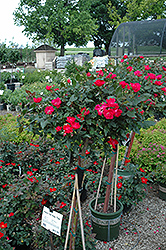Height: 3 feet
Spread: 3 feet
Sunlight:
![]()
Hardiness Zone: 4
Other Names: Knockout Rose
Group/Class: Shrub Rose
Description:
One of the most popular rose tree in the world today, primarily due to its low maintenance, superior disease resistance and incredibly long period of bloom, with seemingly endless cherry red flowers; all roses need full sun and well-drained soil
Ornamental Features
Knock Out® Rose Tree is smothered in stunning lightly-scented semi-double cherry red flowers at the ends of the branches from late spring to early fall, which emerge from distinctive ruby-red flower buds. The flowers are excellent for cutting. It has attractive dark green deciduous foliage which emerges burgundy in spring. The glossy oval compound leaves are highly ornamental and turn an outstanding burgundy in the fall.
Landscape Attributes
Knock Out® Rose Tree is a deciduous dwarf tree, selected and trained to grow in a small tree-like form with the primary plant grafted high atop a standard. Its average texture blends into the landscape, but can be balanced by one or two finer or coarser trees or shrubs for an effective composition.
This dwarf tree will require occasional maintenance and upkeep, and is best pruned in late winter once the threat of extreme cold has passed. Gardeners should be aware of the following characteristic(s) that may warrant special consideration;
- Spiny
Knock Out® Rose Tree is ideal for use as a garden accent or patio feature, and is recommended for the following landscape applications;
- Mass Planting
- Hedges/Screening
- General Garden Use
Planting & Growing
Knock Out® Rose Tree will grow to be about 3 feet tall at maturity, with a spread of 3 feet. It tends to be a little leggy, with a typical clearance of 2 feet from the ground. It grows at a fast rate, and under ideal conditions can be expected to live for approximately 20 years.
This dwarf tree should only be grown in full sunlight. It does best in average to evenly moist conditions, but will not tolerate standing water. It is not particular as to soil type or pH. It is somewhat tolerant of urban pollution. This particular variety is an interspecific hybrid.

